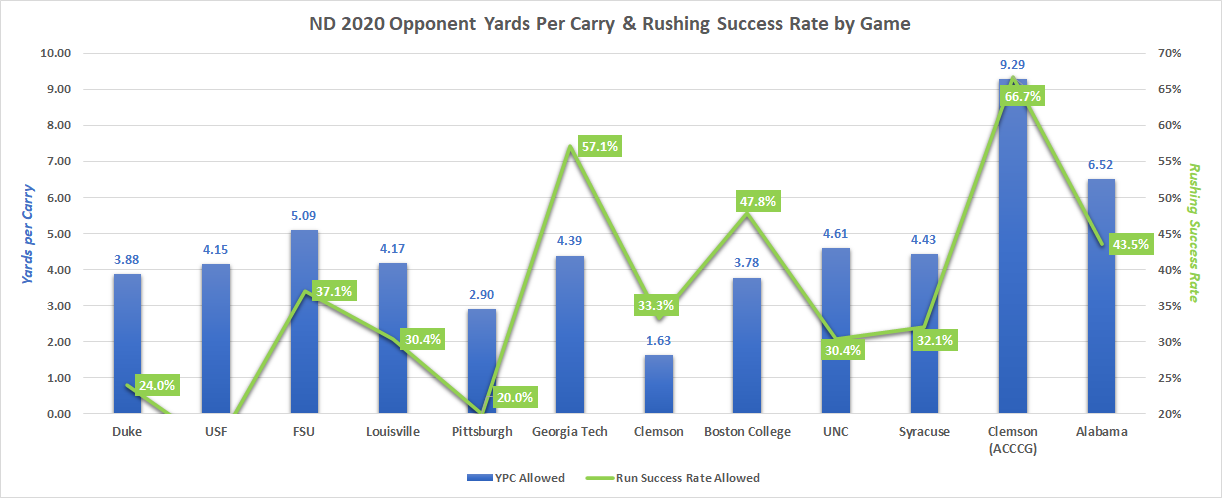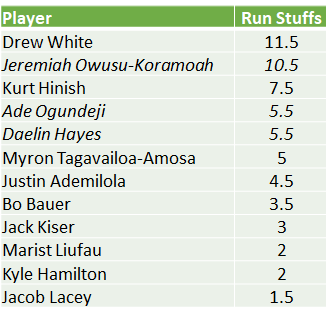This offseason, we’ll be breaking down the performance of each unit – passing and rushing offense and defense – with a look ahead to 2021 and what this means for the Irish. It’s time to examine the run defense, which has been remarkably consistent and solid in the Elko/Lea era. The Notre Dame defense has been strong but not spectacular in yards per carry allowed and run efficiency, ranking in the top-40 nationally but not really sniffing the top ten in these metrics. But the bend but don’t break approach has been very effective, as the Irish have avoided giving up explosive runs. Last year the defense broke through by adding an element of disruption, finishing first nationally in opponent stuff rate – will Marcus Freeman be able to continue this disruption and create a top-10 unit with strong returning pieces in the front seven?
Previous entries:
Rushing Efficiency Allowed

Despite taking many forms over the past four seasons, Notre Dame’s average opponent yards per carry (removing garbage time and not counting sacks) have fallen within a tiny band from 4.60-4.65 yards. The Irish have impressively avoided a significant drop-off in run defense despite high personnel turnover years with draft and graduation losses. Yet until 2020, the defense never broke through with a truly dominant year on the ground statistically.
Much of this can be attributed to Clark Lea’s scheme and overall approach that often prioritized limiting big plays over being as disruptive as possible. In many big matchups, especially post-2018 with consistently good cornerback play becoming a challenge, Lea appeared content to let dangerous passing offenses, like 2019 USC, get their five yards per carry on the ground if it allowed the defense to contain things through the air. The strategic flexibility was also on display when the defense stepped up and limited talented backs like Bryce Love, D’Andre Swift, Breece Hall, AJ Dillon, and Travis Etienne (once at least).

Then in 2020, the run defense evolved into its strongest form yet. In the ten regular-season games, only one opponent, FSU, cracked five yards per carry. Just two teams – Georgia Tech and Boston College – managed above-average efficiency on the ground in the same stretch. Those performances were comprised of short conversions for first downs versus any real traction in the rushing game, with both teams held to less than 125 yards. The Clemson sequel and Alabama game quickly upended many rushing statistics, but against Trevor Lawrence and the Tide’s cadre of Heisman finalists getting stops on the ground was just one of many defensive issues.
Despite the late struggles, Notre Dame’s underlying run efficiency numbers were solid. The Irish finished 8th in line yards allowed, which measures the yards given up that the defensive line should be credited for. Lea’s group was also 24th in opportunity rate allowed, the percentage of carries where opponents gain at least four yards. Impressively these efficiency numbers remained strong while the defense dramatically increased its stuff rate to among the best in the nation.
Rushing Explosiveness Allowed

While the defense surged to best in the power five in run stuff percentage (runs for no gain or negative yardage), it wasn’t without tradeoffs. The Irish didn’t dramatically increase their rate of 12+ yard runs allowed versus previous seasons, but they did allow more medium-length runs. These don’t quite qualify as explosive runs, but Notre Dame allowed 10+ yard gains on 14.7% of runs, which ranked 81st last season. Clark Lea’s defense was better limiting longer runs, ranking 52nd in 20+ yard gain percentage and better than the national average. But the 2020 version of the ND run defense was a little more boom or bust than previous iterations.
Still, the busts weren’t that common, as the defense allowed just eight runs of 20+ yards over the 12 game season, and unsurprisingly some of the biggest explosive gains given up came against Clemson and Alabama. Of Notre Dame’s five longest runs yielded in 2020, three came in the final two contests – the 53-yard Najee Harris hurdle, the backbreaking 44-yard Travis Etienne touchdown on 4th and 1, and a 34-yard Trevor Lawrence keeper.

The stuffs were evenly balanced between individuals in the front seven and position groups. For as spectacular as Owusu-Koramoah was last year, Drew White tallied more run stuffs playing in the middle of the defense and flashing his terrific instincts. Hinish and MTA on the interior also each chipped in strong numbers, with the ability to penetrate as well as eat up blocks for the linebackers. Considering their relatively low snap counts, seeing Justin Ademilola, Jack Kiser, and Marist Liufau chip in here is encouraging as each attempt to step into a larger role in 2021.
2021 Outlook
No unit offers more certainty it will be near playoff-caliber than the Irish rushing defense. The entire interior of the defense returns, including the incredibly deep defensive tackle rotation and Drew White leading the linebackers. Oh, and just in case anyone slips through behind them is a generational safety. JOK will be missed, of course, and it would be foolish to assume that somewhat green defensive ends will replicate Hayes and Ogundeji’s strong performance against the run. But this is a unit that returns too much and has far too strong a track record to worry about a precipitous decline.
The biggest unknown variable in this equation is Marcus Freeman and his adjustments to the defensive scheme. His reputation for simplicity and aggression could portend another season filled with negative plays created by the defense, but will it open things up more frequent long runs? Cincinnati finished top-20 in havoc rate each of the past three seasons, could still limit big rushing plays (6th in rate of 10+ yard rushes allowed / 17th in rate of 20+ gains). His scheme has worked to produce similar results to the Irish run defense last year, so it really comes back to the duration and intensity of potential growing pains.
The strength of the Irish pass defense could also play a role. There are more outstanding questions with that facet of the ND defense, with concerns at cornerback and one safety position combined with a retooled pass rush. Will Freeman have to dial down the aggressiveness and number of men in the box to ensure Notre Dame can contain UNC and USC’s passing attacks? Or against teams that project to be stronger on the ground, like Virginia Tech or Georgia Tech, will that leave the Irish secondary too exposed one on one?
That’s as far as you can go poking holes in the run defense projections, and thankfully there isn’t a Clemson or Alabama on the schedule (at least, not yet) in 2021. While Wisconsin, USC, and UNC should be fairly well-rounded, the Notre Dame defense should have a significant advantage against most offensive lines and be without concern about dominant rushing opponents.




Great breakdown. I’m curious to see how the Freeman defense does compared to the past few years of Elko/Lea. I just hope that they continue the practice of liberally rotating guys in and out to get them experience and to keep them fresh
Can’t speak to Freeman’s philosophy there but I think you can be pretty confident it will be a deep rotation in the front seven. The DL easily goes 10 guys deep that have already seen meaningful snaps and the LB two deep doesn’t have many weak links. They’re experienced and I don’t know that there’s a ton of separation at many positions – probably Drew White and maybe MTA?